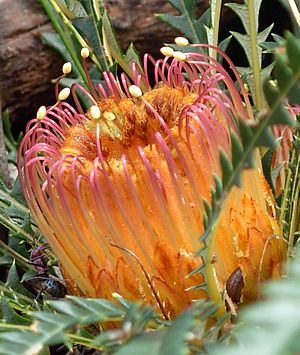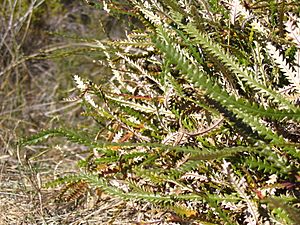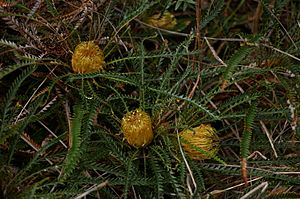Honeypot dryandra facts for kids
Quick facts for kids Honeypot dryandra |
|
|---|---|
 |
|
| Banksia nivea in Kalamunda National Park | |
| Scientific classification | |
| Genus: |
Banksia
|
| Species: |
nivea
|
| Synonyms | |
|
|

The Banksia nivea, also called honeypot dryandra, is a type of rounded shrub. It grows only in Western Australia, meaning it is endemic there. The Noongar people, who are Indigenous Australians, call this plant bulgalla.
This plant has long, narrow leaves with many triangular parts. It produces heads of cream-coloured flowers that can also have orange or red parts. After flowering, it forms smooth, egg-shaped seed pods called follicles.
Contents
What it looks like
The honeypot dryandra is a bushy shrub with many branches. It usually grows up to about 1.3 metres (4 feet) tall and wide. Unlike some plants, it does not have a special underground stem called a lignotuber that helps it regrow after a fire.
Its leaves are long and narrow, measuring between 200 and 450 millimetres (8–18 inches) in length and 3–10 millimetres (0.1–0.4 inches) wide. Each leaf has a stalk, or petiole, that is 10–60 millimetres (0.4–2.4 inches) long. Along each side of the leaves, there are between 45 and 85 small, triangular parts.
The plant's flowers grow in heads at the ends of its branches. Each head contains seventy to ninety cream-coloured flowers, which can also have orange or red colours. At the base of the flower head are special leaves called involucral bracts, which are oblong to egg-shaped and about 18–22 millimetres (0.7–0.9 inches) long.
Each flower has a perianth (the outer parts of the flower) that is 25–38 millimetres (1–1.5 inches) long. The pistil, which is the female part of the flower, is 32–45 millimetres (1.3–1.8 inches) long. The honeypot dryandra usually flowers in April or from July to November. After flowering, it forms egg-shaped seed pods, or follicles, that are 9–13 millimetres (0.4–0.5 inches) long and mostly smooth.
How it got its name
The Banksia nivea was first found by a French explorer and botanist named Jacques Labillardière. He collected it near Esperance Bay in Western Australia in December 1792. He was looking for another lost naturalist at the time.
Labillardière officially described and drew the plant in his book about his journey, which was published in 1800. For a while, this plant was placed in a different group of plants called Dryandra. However, in 2007, scientists decided to move all Dryandra species back into the Banksia group. This means the plant's original name, Banksia nivea, was used again.
Where it lives
The honeypot dryandra is found across a wide area in Western Australia. It grows between Lake Indoon (near Eneabba), Ongerup, and Israelite Bay.
This plant grows in different types of environments. Some varieties prefer woodland areas and a type of shrubland called kwongan. Other varieties have a smaller living area, found east of Busselton and on the Scott River plain, where they grow in thick scrub.
Animals that visit
Many animals interact with the honeypot dryandra. Birds that feed on nectar, like the Western spinebill, have been seen drinking from its flowers.
Black cockatoos also feed on the seeds of this plant. It's not always clear which specific type of black cockatoo is seen, but it could be either Baudin's black cockatoo or Carnaby's black cockatoo.
Conservation status
The Western Australian Government's Department of Parks and Wildlife checks on the health of different plant species. Most honeypot dryandra plants are considered "not threatened," meaning they are not currently at risk of disappearing.
However, one specific variety of the honeypot dryandra is classified as "Threatened Flora". This means it is a rare plant that needs special protection to make sure it survives.


